
Today, keeping unique aquatic species is now commonplace thanks to ever-advancing filtration technology. By providing excellent water quality, many of our fish will live much longer in our care than they would in the wild.
Non-aquarists and beginners often think that a filter will keep the water clean. They logically assume that the tank is in top shape if the water lacks an "off color” or floating particulate. Clear water is an indication that the filtration system is partially effective, but beneficial bacteria inside the filter at the microscopic level actively converts harmful compounds into less dangerous substances. This bacteria, combined with partial water exchanges, is what enables hobbyists to keep bioloads (biological loads) higher than found in nature. Bioloads are demands placed on filtration as a result of the metabolic activity of all the living organisms in the aquarium.
The aquarium industry normally divides filtration into three stages: mechanical, biological and chemical.
Biological: This includes beneficial bacteria colonizing on a media such as bio-balls, sponges, bio-wheels or gravel. Toxic dissolved compounds like fish waste and uneaten food are consumed by the microscopic bacteria and ultimately converted into less harmful substances.
Mechanical: This includes filter floss, filter cartridges or anything capable of screening out particulate, such as fish food, fish waste and free-floating plant material.
Chemical: This includes activated carbon, zeolite and phosphate absorbers. These media absorb or bond with dissolved organic compounds, such as ammonia or fish medications.
Some filters provide only one type of filtration, such as the biological sponge. But many filters are capable of providing all three types of filtration.
Selecting which filter is best for your aquarium can seem quite daunting with more than 30 manufacturers offering several models in different trim and power options. But defining capabilities, advantages and disadvantages should help you make an informed decision. We will first examine filters and later filter monitoring equipment most commonly available to the hobbyist.
Manufacturers rate their equipment using quantifiable and subjective data. Gallons per hour flow rate and watts used are quantifiable. Recommended tank size for a filter is subjective. All of the below information is important when selecting a filter for your aquarium.
Gallons per hour (GPH): Often called flow rate, this is the maximum number of gallons of aquarium water that will flow through a new filter with new filter media, pumping at zero head height. A canister filter sitting on the floor might have to push water up as high as 4 to 6 feet to reenter the tank (i.e., head height) depending on the height of the aquarium and stand. This 4 to 6 foot height significantly reduces the gallons per hour passing through the system.
Turnover rate: This term is erroneously used as a synonym for gallons per hour. They are absolutely not the same. You might reasonably think that a filter rated at 500 GPH will process all of the water in a 50-gallon aquarium 10 times in one hour. This is not accurate, and here is why: Some of the filtered water will be immediately refiltered while some dirty water will remain unfiltered for an undetermined amount of time. This is because some water will swirl around the interior of the tank for some amount of time before reentering the filter. Some water will sit in dead zones behind decorations, calm areas such as caves or in between rocks and only pass through the filter occasionally.
Short of solving complex mathematical equations, try to provide maximum flow-through filtration by drawing dirty water from the bottom of one end of the tank and returning filtered water near the surface at the opposing side of the tank. Using more than one filter helps increase the turnover rate.
Filters can be placed in the tank or work outside of the tank. In-tank filters include sponge filtration, undergravel filters and power filters. External filters include hang-on-the-back filters, wet/dry filters and canister filters.
Sponge filtration is ancient technology but still used because of its virtual unparalleled biological filtration. Sponges are primarily biological filters although they do provide a slight degree of mechanical filtration. Its tremendous surface area encourages enormous colonies of beneficial bacteria to grow. Cleaning is as simple as squeezing the sponge in a bucket of old aquarium water removed during a partial water exchange.
Sponges are well-suited for breeding aquariums where baby fish would certainly be sucked into a normal power filter. Sponge filters connected to a power filter are especially effective at providing flow-through water circulation. Every one of my fresh or brackish water tanks has two filtration systems, one of which is always a sponge filter.
Undergravel filters developed a bad reputation after being widely introduced in the 1960s and promoted as "filters that make water changes obsolete.” They are without a doubt the least understood filters in the aquarium hobby.
Undergravel filters are the most unobtrusive internal biological filter. They are excellent biological filters if correctly installed and properly maintained. Inexpensive to purchase, lasting for many years and with nothing to replace during maintenance makes them a "dirt cheap” filtration choice. The downside, however, is that undergravel filters are not a good choice for beginner aquarists due to the filter’s specific needs. It is essential to use the correct gravel size and depth. Additionally, big objects such as rock decorations with large, slate bases block filter flow, which results in "dead zones” across the filter plates. Hydro-vacuuming the entire gravel bed as needed is essential to prevent clogged areas resulting in a rotten egg smell from the creation of hydrogen sulfide. These filters provide excellent water circulation throughout the tank if properly installed and driven by an internal powerhead.
Power filters are small, internal filters capable of all three stages of filtration. These can be installed horizontally or vertically and are easily concealed. They are ideal for partially filled tanks, because the water level is irrelevant to these completely submerged units. Flow-through water circulation efficiency can be excellent in aquariums with few obstructions. This assumes a proper size filter (GPH output) is selected for a particular tank.
Hang-on-the-back (HOB) filters are the most popular filters used and are suitable for tanks ranging from 5 to 80 gallons. They are capable of handling all three stages of filtration and do a fine job. Filter cartridges are easy-to-change and filter assembly/disassembly is simple. Priming these filters is as easy as pouring enough tank water into the filter to prime it and plugging it in. If you didn’t set aside any water, prime the pump with water treated for chloramines.
Keep the aquarium’s water level about one-half inch below the tank’s frame to gain maximum performance. Flow-through circulation is not as effective when compared to, say, a canister filter. This is mainly due to the filter’s uptake tube being mounted virtually underneath the filter’s water return and the HOB location. Filtered water flows out and across the width of the tank rather than the length of the tank, resulting in the refiltering of a certain amount of freshly filtered water. HOBs are outstanding filters, I use them. If you are looking for maximum cross-tank circulation, consider including a sponge or internal power filter.
Wet/dry filters (also called trickle filters) are used primarily by the advanced hobbyist who needs enormous amounts of biological filtration. The water trickles over nonsubmerged media, such as bio-balls, affording maximum air contact time for nitrifying bacteria to consume toxic substances. Wet/dry filters can provide biological filtration only or be outfitted to include chemical and mechanical stages. They are externally mounted (normally on the floor under the tank) and require a separate pump and plumbing. Wet/dry filters provide excellent flow-through circulation, primarily due to water being removed from the top corner of one end of the aquarium and returned at the other end of the tank.
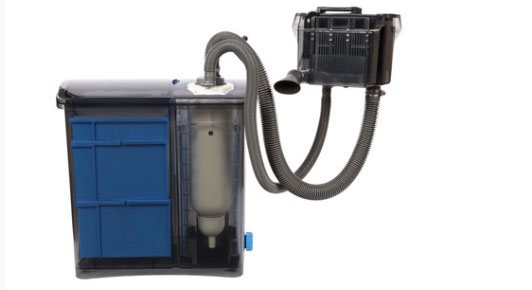
Canister filters are the crème de la crème of filtration. They provide all three stages of filtration and are available for aquariums ranging from mini to those holding hundreds of gallons of water. Canisters provide superb flow-through circulation delivered by a virtually silent pump. Aquarium water can be maintained at any level, making canisters ideal for partially filled tanks containing exotic species, such as mudskippers, which require land areas, or archerfish, which enjoy "shooting” bugs from emergent growing plants like mangroves.
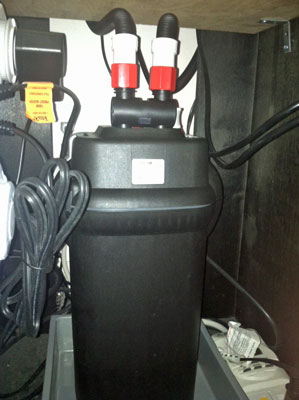
Canister filters sit outside the aquarium. Photo by Melissa Ramirez
Canister filters have a huge capacity for housing multiple layers of filter media. Manufacturers offer many features such as water trickling through bio-wheels to further enhance the biological activity, water polishing inserts, UV sterilization, built in heaters and a plethora of biological, mechanical and chemical media.
Recent innovations have occurred with hang-on-the-back and canister filters, and with filter pads. Filtration is traditionally described as being three stages — mechanical, chemical and biological — but that has changed. Some manufacturers have subdivided the HOB mechanical and biological functions, which has resulted in five stage filtration. The five stages are:
1st stage: A mechanical pre-filter constructed from a very porous foam or screen that traps large particulate matter.
2nd stage: A disposable mechanical filter pad for capturing fine debris.
3rd stage: A chemical insert filled with activated carbon, zeolite or a combination of the two.
4th stage: A biological screen providing a medium for massive colonies of biological activity.
5th stage: A biological trickle compartment filled with ceramic media. This oxygenated compartment provides an ideal environment for beneficial bacteria to rapidly convert toxic compounds into less harmful substances.
A new patent entered by an Austrian inventor/hobbyist claims to revolutionize HOB filtration with a back-flush capability. Back-flushing is simply reversing the water’s flow to unleash large particulate trapped in the filter. This technique has been used in the aquaculture industry for many years, but never for HOB filtration at the hobbyist level. The inventor claims the "Aqua Genie HOB filter” is the first HOB to incorporate an instant filter-flush system, allowing quick removal of most large particulate in only a few seconds of time. The unit is able to do this with minimum loss of water. The exact process is proprietary information.
Natural methods of filtration are also important because they assist the various types of manufactured filtration equipment. Live plants are a proven way to reduce nitrates and generally improve aquarium water quality. Live plants are one of nature’s best organic filters. They are capable of uptaking metals like copper, which might remain after a fish disease treatment. Live plants, combined with artificial filtration, enhance the overall efficiency of your tank’s filtration system.
It has been nearly six years since the introduction of electronic monitoring. One manufacturer produces two canister filters that alert the hobbyist that the system requires attention. A few of the electronically monitored features provide information, such as the impeller needing servicing, high and low temperature alarms and low water flow. This electronically monitored canister filter additionally includes the capability to change filter cartridge inserts without stopping and disconnecting the filter from the tank.
A less sophisticated (but certainly useful) non-electronic monitor is offered by another canister filter manufacturer. It is in the form of two dials conveniently mounted on the top of the canister filter. After maintenance, simply turn the appropriate dial indicating the date of a water exchange or the date the canister media was serviced. These dials are simple to use, convenient and thankfully replace the stickers most of us use as reminders.
Recently, manufacturers have introduced new chemical filtration pads. Some of these pads can be recharged up to six times before needing replacement. Other choices include super adsorbent pads capable of removing ammonia, heavy metals and phosphates.
Water flow monitors are slowly making their way into the aquarium hobby. Some are specifically marketed for aquarium use but, oftentimes, hobbyists are adapting commercial flow meters intended for garden use or reverse osmosis (RO) units. Water flow meters are normally installed "in-line” on a canister filtration system and indicate the amount of water flowing through the system. As a filter becomes clogged by debris, its flow decreases and the water flow monitor should indicate a drop in the gallons per hour passing through the device. Two types of water flow monitors are available:
1. Electronic units that are capable of indicating the current (GPH) flow rate. More sophisticated (and expensive) units provide current GPH and the cumulative number of gallons that have passed through the system since the last service.
2. Non-electronic devices that look like thermometers. These units use water pressure to lift a weight from the bottom of a clear tube. As the weight rises, it is viewed against a graduated scale printed on the tube. The hobbyist only needs to create a bench mark by recording the beginning water flow and then periodically checking the device for changes.
Another benefit of water flow monitoring and the use of a bench mark is the capability of detecting the slow degradation of the impeller or a slowly kinking hose. Following filter servicing, if the performance is not up to the bench mark, further investigation is warranted.
While we hope even-simpler-to-maintain equipment will soon emerge, maintaining the delicate water conditions our fish require couldn’t be easier with the current selection of filtration equipment. As aquarists, we have an obligation for providing good stewardship for all of our tank’s inhabitants. We wish you success!
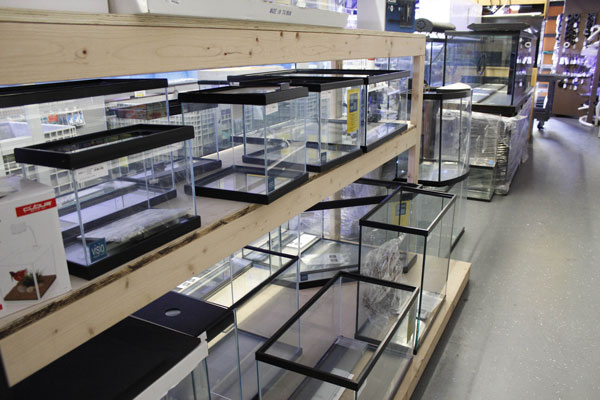 Five Tips for Freshwater Aquarium Success
You spent countless hours researching the latest products to
Five Tips for Freshwater Aquarium Success
You spent countless hours researching the latest products to
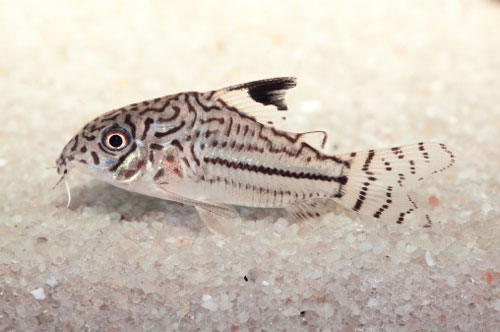 Keep Your Aquarium Clean With These Tank Tools
Success in maintaining a freshwater system takes applied kno
Keep Your Aquarium Clean With These Tank Tools
Success in maintaining a freshwater system takes applied kno
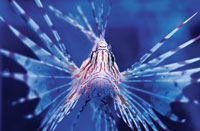 Invasive Aquatic Species
Last column, we discussed invasive species and the potentia
Invasive Aquatic Species
Last column, we discussed invasive species and the potentia
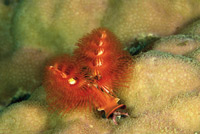 Aiptasia
Q. I have Aiptasia all over my aquarium and have been
Aiptasia
Q. I have Aiptasia all over my aquarium and have been
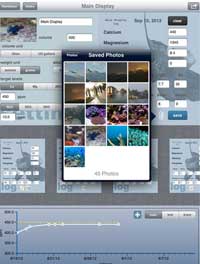 Reefdoser Pro for iPad Ships
Reefdoser Pro for iPad Ships
Copyright © 2005-2016 Pet Information All Rights Reserved
Contact us: www162date@outlook.com